

 When I started planning this trip one of the things that I knew that I had to do was to walk Pickett's Charge. That's what I set out to do on the afternoon of the day that I visited the battlefield. Much like the weather of the actual day of the battle the temperature was in the upper 80's, the sky was clear, the breeze was soft and warm. To me it was a perfect summers day. Lee had ordered a cannonade on the Federal postion that was to be the focal point of the infantry attack. His thinking was that the cannonade would drive the northern guns and troops from the heights. At just after 1:00 in the afternoon the southern cannons openned fire. The depth of the Federal lines was rather shallow and the Confederate artillery did not have much in the way of enfilade fire, this caused most of the southern fire to be long, much of it overshooting the Yankee's postion. The Yankee foot soldiers laid down behind the stonewall to shelter themselves as best they could from Rebel missiles. Some even fell asleep. The northern infantry suffered little from the cannonade, the northern artillery men did not fair as well. Union Brigadier General Henry J. Hunt in command of all the northern artillery ordered the return fire to cease, hoping that this would convince Confederate Army that his guns had been silenced. His plan worked well, because as soon as Confederate General Longstreet received word that the Yankee guns were withdrawing, he ordered Pickett into action with a nod of his head.  As I stepped off the line from the edge of the trees on Seminary Ridge looking east I could see the slight rise in the ground that eventually dropped off onto the sunken, invisible from my position, Emmitsburg Road. Nearly a mile from me and my goal was the group of trees on the far ridge, known today as the "Copse of Trees".  This walk was rather amazing, for I would spend over an hour alone in the middle of the battlefield. As I walked along I looked to my right and to my left, in the nearly waist deep grass I could imagine being in the middle of the ten to twelve thousand men that marched across this field on the afternoon of July 3rd, 1863. I could see the reflection of the sun off the thousands of bayonets as we marched along in perfect formation, I could hear their footsteps, the rattle of their equipment, the sound of their regimental flags flapping in the breeze, the shouts of encouragement of their commanders leading them on. Pickett's Division was on the right, Pettigrew's Division was on the left and Trimble's in support of and following Pettigrew's. Pickett's Division was made up of three brigades of Virginians commanded by Brigadier General Richard Brooke Garnett, Brigadier General James Lawson Kemper, and Brigadier General Lewis A. Armistead. Pickett's force was as far off to the right as they were in depth of the battlefield away from the intended point of attack. This required Pickett's force to change direction several times, known as 'changing front'. As Pickett's men passed in front of the Federal First Corps position they were flanked by a brigade of Vermont soldiers commanded by Brigadier General George J. Stannard. Kemper's Birgade, on the right of Pickett's line, was attacked from behind by Stannard's brigade and enfiladed by artillery on the ridge. Kemper's brigade withered under this distructive fire.  When the three divisions made it to the Emmitsburg Road they found a strong fence on each side, as the advance was slowed by these fences, the Federal guns opened fire again. The acrid smell of gunpowder filled the air. The range was less than 200 yards. Entire companies were wiped out with a signal blast of a cannon, the Rebels advanced but they could not see any of the Federal Infantry.  Garnett's and Armistead's objective was the group of trees in the above picture. As Garnett's men advanced up the hill, the Federal Infantry of the Major General Winfield Scott Hancock's Second Corps suddenly rose from behind the stonewall and hundreds of musket's opened fire, much of Garnett's column seemed to sink into the ground. "Don't double-quick." Shouted Garnett over the din of battle, "Save your wind and ammunition for the final charge." With these words Garnett slumped forward on his horse, he had been shot several times. His unmanned horse emerged from the smoke, wounded, galloping toward the rear. How many times had Garnett been shot, no one knows. His body was never found. Since he wore a blue coat, perhaps he is buried in an unmarked grave along with the Federal soldiers in the National Cemetery. | ||
 |

|
|